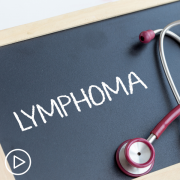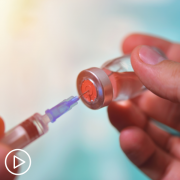Relapsed DLBCL Treatment: What Are the Options?
Relapsed DLBCL Treatment: What Are the Options? from Patient Empowerment Network on Vimeo.
What are the treatment options for relapsed diffuse large B-cell lymphoma (DLBCL)? Expert Dr. Robert Dean explains approaches for relapsed DLBCL patients and considerations that may alter the treatment course.
Dr. Robert Dean is a hematologist/medical oncologist at Taussig Cancer Institute at the Cleveland Clinic. Learn more about Dr. Dean, here.
See More From The Pro-Active DLBCL Patient Toolkit
Related Programs:

|

|

|
Transcript:
Katherine:
Are treatment considerations different for patients with relapsed disease?
Dr. Dean:
I’d say that they’re similar in a lot of ways. The first is, in my mind, again, is the patient that I’m seeing somebody who could potentially tolerate treatment that would be given with the goal of trying to cure their lymphoma on a second try?
Some patients with relapsed large B-cell lymphoma can be cured with the most common standard second-line approach, which is to get them back into remission with some standard chemotherapy, and then to follow that with a very intensive course of high-dose chemotherapy as a one-time treatment that’s given with a stem cell transplant using the patient’s own preserved healthy bone marrow stem cells. That treatment’s effective in about half of patients that can undergo it and you need to be pretty fit medically and in an overall physical sense to be able to get through that treatment okay and have a good healthy recovery afterward.
So, it’s not for everyone, but it is doable in a lot of patients. The other questions or considerations that I think are important are if a patient is sort of on the border in terms of their overall health and their willingness to undergo really rigorous intensive treatment as a second try.
We have to look, in a balanced way, at what their goals are as an individual and what it’s going to take for them to try to reach those goals. I don’t easily back away from recommending to someone that I think has a shot at cure that they should go for it if they’re medically in reasonable shape to try for that. But there’re some people who, after their initial course of treatment, decide that they don’t want to pursue intensive treatment anymore and would rather go with a lower-intensity approach that might not have the potential for cure, but that wouldn’t be as demanding of them physically or logistically.
The logistics are another factor for some patients because most patients with large B-cell lymphoma can get treated with a standard treatment approach like R-CHOP as their initial treatment at someplace that’s easily accessible to them where they live.
But the advanced treatments that are used to try to cure patients with relapsed large cell lymphoma, like a stem cell transplant, or like engineered CAR T-cell therapy, are only offered at large hospital-based cancer centers. And for some people, signing up to go and undergo that kind of treatment, to go through a long hospital stay, to be far away from family and home for a long time like that, and then have a longer recovery afterward, is something that they aren’t always comfortable with and really need some coaching through to figure out how all that aligns with their goals.
Most people, in my experience, are willing to go through what they have to if we think, and if they feel like, they’ve got a decent shot at getting cured on a second try. But that’s part of the discussion that we have when we’re talking about what their options are because there are less intensive approaches available.
They just don’t carry that same potential for cure.










